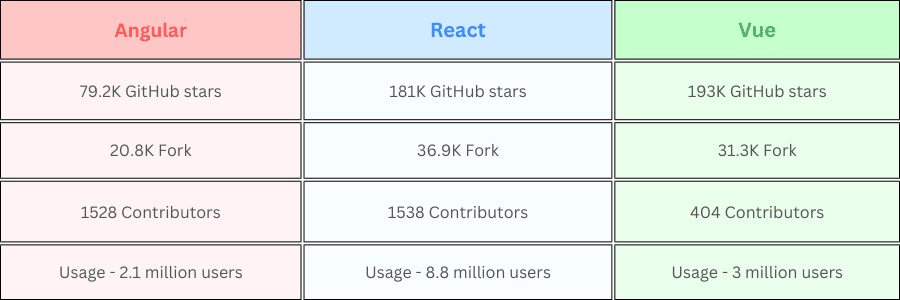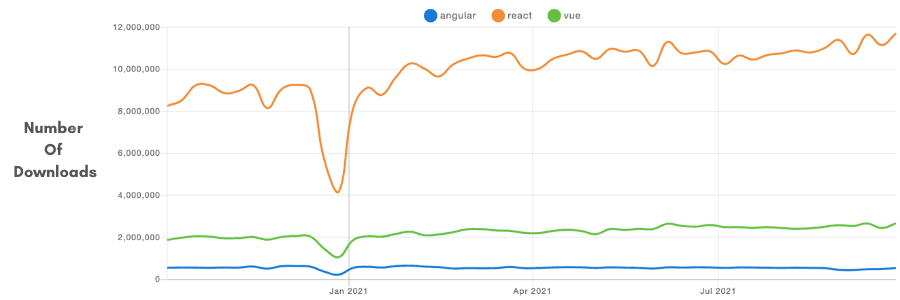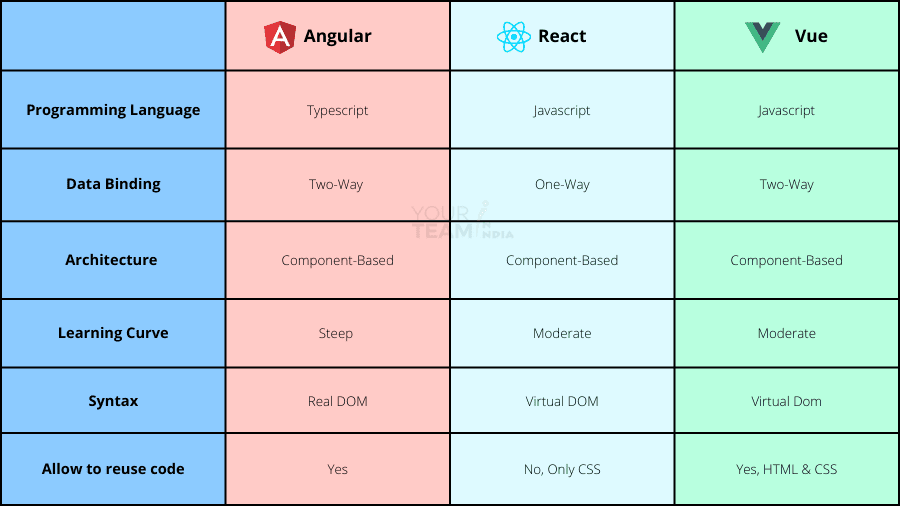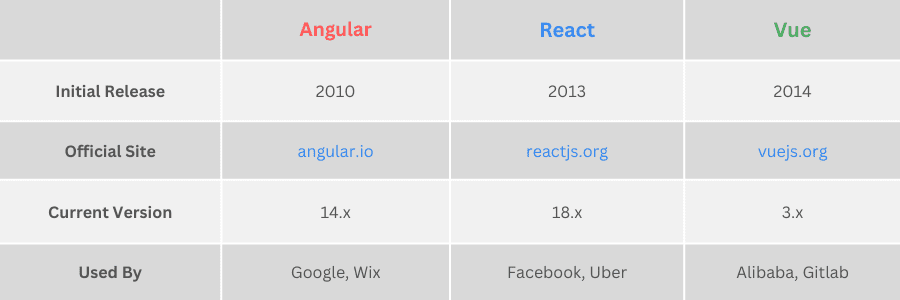Quick Summary: Explore the ever-evolving landscape of front-end development as we compare Angular vs React vs Vue in 2025. Delve into their strengths, weaknesses, and use cases to help you make an informed decision on the ideal framework for your next project.
There is just one language that has a monopoly in front-end programming, and that language is JavaScript. The situation with JavaScript frameworks is different, and what makes it even harder to select one is that JS has 24 frameworks and more than 83 libraries, each with a distinct capability. Angular vs React vs Vue
According to a recent Statista survey, 65.36% of developers said that JavaScript is one of the main reasons they like the language. JavaScript has been used to create desktop and mobile applications in recent years for both client-side and server-side programming languages.
Because there are so many frameworks accessible, JavaScript developers frequently become perplexed when trying to select the best framework. Many developers search for the best JavaScript framework, but it's important to consider specific project needs, as there is no one-size-fits-all answer. The top JavaScript frameworks that continue to advance quickly are Angular, React, and Vue.
From booking a ticket to ordering food to book a cab to online shopping, applications have been dominating the business world for a long time. There are thousands of apps available and therefore, building one is not a problem. Choosing the best user interfaces and web development frameworks for your application is a matter to discuss. Hence, let’s dish out everything we have on Angular vs React vs Vue, the three JavaScript frameworks most commonly compared by developers.
Key Differentiators - Angular vs React vs Vue
- Angular: A comprehensive framework with built-in features and strong typing through TypeScript, offering a structured approach to application development.
- React: Developed by Facebook, it emphasizes flexibility and component reusability, allowing for a more modular approach to building applications.
- Vue: Known for its simplicity and ease of integration, Vue provides a gentle learning curve while still offering a powerful and scalable solution for various project sizes.
Introduction to Frontend Frameworks
In today’s fast-paced digital landscape, frontend frameworks have become indispensable for building complex web applications. These frameworks provide developers with a solid foundation, offering structure and consistency that streamline the development process and make it easier to manage large teams and projects. Angular, React, and Vue are at the forefront of this movement, each bringing unique philosophies and toolsets to the table. Whether you’re developing a dynamic dashboard, an interactive e-commerce site, or a feature-rich enterprise solution, choosing the right frontend framework is crucial. The decision often comes down to the specific needs of your project—such as scalability, maintainability, and the ability to handle complex web applications—as well as the strengths of frameworks like Angular and React in meeting those demands.
Angular vs React vs Vue - Philosophy & Background of each Framework?

Angular
Developed by Google in 2009, Angular is an open-source framework for dynamic web apps and is now known as one of the biggest frameworks. Developers use the Angular CLI to quickly scaffold and manage an Angular app, streamlining the setup and development process. It offers support for many things including full control of the user interfaces, reaction to user input, input validation in forms, routing, state management, sending HTTP requests, and many more.
Angular brings so many features to its bucket, allowing one to build, manage, and test an application most efficiently and effectively. An Angular application is structured with modules, components, and services, making it ideal for building complex single page applications. Angular projects are organized to ensure scalability and maintainability, which is especially important for enterprise apps. Angular powers a significant number of enterprise-level websites and applications due to its robust architecture. Also, in the jungle of front-end JavaScript frameworks, Angular has set out its place to be one of the most popular frameworks. Angular uses lifecycle hooks to manage component behavior and rendering stages, and it adopts reactive programming with RxJS to efficiently handle asynchronous data streams. Working with Angular requires developers to write code in TypeScript, which enhances maintainability in large projects.
Recommended Read: Why Vue Native is Better Than Other JavaScript Frameworks?
Here are some of its pros -
Pros:
- Ensures outstanding app performance;
- Provides PWA capabilities and offline support for app development;
- Offers in-built features for building large-scale applications;
- Angular projects may be expanded, scaled, and developed more quickly.
Recommended Read: Top 13 Advantages of AngularJS for App Development
React
Also known as React.js, React is an open-source framework based on JavaScript that enables users to create interactive user interfaces and the front end of the application. Developers often start by creating a React app using tools like Create React App, which sets up the environment for building modern web applications.
Even though React is from the young library of JavaScript, it has maintained its place by providing excellent features and functionalities. A React application is structured around reusable components, making it easy to build and maintain complex user interfaces. The React library is focused on the view layer, offering flexibility in integrating with other tools. React thrives in building dynamic, interactive interfaces and benefits from a large, active community. It supports concurrent rendering, which improves UI responsiveness in highly interactive applications. React excels at building UI components, allowing developers to create modular and reusable interface elements. Developers can also choose their own libraries for state management and routing, providing flexibility in application architecture.
Over the years, it has been growing as a Virtual DOM to make the comparison of previous HTML code differences easier. It offers multiple tools to define what can be rendered and under which circumstances.
Here are some pros and cons of using React -
Pros:
- Quicker loading;
- Data and presentation can be separated using React;
- It has single file components containing both - markup and logic.
Cons:
- It is just a JavaScript library, not a complete framework;
- It is not possible to implement MVC architecture;
- It is insufficient to build web apps as it needs the support of other react libraries.
Recommended Read: 15 Advantages of ReactJS for Application Development
Vue
Vue is one of the most discussed among other JavaScript frameworks. It sits between Angular and React. Developers can quickly set up a Vue app using the Vue CLI, which streamlines the process of building modern web applications.
Vue is a progressive framework as it offers the functionality to create progressive web apps. A Vue project is organized around components and single file components (.vue files), supporting scalable and maintainable development. Vue is about building user interfaces with a combination of reusable components, just like angular and react. The Vue ecosystem includes official libraries like Vuex and Vue Router, providing a well-integrated experience for state management and routing. Vue Router is the official solution for managing navigation and URL handling in Vue applications. Vue allows developers to define template, script, and style in the same file, promoting modularity and ease of maintenance. Vue is also compatible with other frameworks, making it easy to integrate Vue into existing projects or alongside other technologies. A good mobile app development company will be able to give you a detailed comparison of Angular vs React vs Vue.
Here are some pros and cons of Vue -
Pros
- It comes with detailed documentation;
- Its reusable components make the development process much easier;
- It has a possibility of Component-based architecture (CBA);
- It offers simplicity and flexibility in mobile app development.
Cons
- Its community support is not as wide as React and Angular;
- It has limited plugin availability.
Overview of JavaScript Frameworks
JavaScript frameworks have transformed the way developers approach web development, making it easier to create robust, scalable, and maintainable applications. Among the top choices, Angular stands out as a full-featured framework designed for large scale applications and complex single page applications. It provides a comprehensive suite of tools for building everything from reusable UI components to advanced state management, making it ideal for enterprise-level projects.
React, often referred to as a JavaScript library rather than a full framework, excels at building user interfaces through its component-based architecture. Its flexibility allows developers to create highly interactive and reusable UI components, making it a popular choice for both small and large projects. React’s focus on building user interfaces and its efficient virtual DOM make it a go-to solution for dynamic single page applications.
Vue, known as a progressive JavaScript framework, combines the best aspects of Angular and React. It offers a gentle learning curve and a simple, intuitive approach to building user interfaces. Vue’s core library focuses on the view layer, but its ecosystem supports everything needed for complex web applications, including state management and routing. This makes Vue a solid choice for developers seeking a balance between simplicity and power when building single page applications or larger projects.
Angular vs React vs Vue - Comparing the Market Trends

Angular
- 79.2K GitHub stars
- 20.8K Fork
- 1528 Contributors
- Usage - 2.1 million users
React
- 181K GitHub stars
- 36.9K Fork
- 1538 Contributors
- Usage - 8.8 million users
Vue
- 193K GitHub stars
- 31.3K Fork
- 404 Contributors
These statistics and figures show that Vue is outpacing React and Angular, and is clearly in the lead. Despite being a community-driven framework, it has the power to draw developers' attention. By providing the ray of features, it guarantees experienced developers a well-built and simple component-based development architecture.

However, we can't disregard Angular and React's features. These enormous industries have, after all, expressed interest in these frameworks. We still have a lot more things to discuss on Angular vs React vs Vue.
Angular vs React vs Vue - Key Differences
Here are some key differences between Angular vs React vs Vue -
When choosing between these frameworks, it's important to consider your specific project requirements and the complexity of the tasks you need to accomplish. Each framework is designed to help developers manage complex tasks in modern web development, offering different features and approaches to suit various needs.

1. Architecture
Angular.js - Speaking about architecture, Angular.js is a complete MVC framework that gives you all the options for programming right out of the box. These options include opportunities to create forms, angular applications, HTML-based templates, components testing utilities, dependency injection, encapsulation of CSS components, AJAX requests, routing, and more.
React.js - In contrast, React.js is a framework that only provides the view, leaving it up to the developer to determine how to build the Model and Controller. The characteristics offered are XML-like JSX language is utilized in place of templates, no introduction of dependencies, AJAX requests, and more.
Vue.js- Vue.js is a library that makes it possible to design interactive web user interfaces. The ViewModel layer of the MVVM architecture is the main focus of Vue.js. The View and the Model are joined together through two-way data bindings. DOM activities and output formatting are abstracted away by directives and filters.
2. Data Binding
Angular.js - In Angular.js, two-way binding is used. Before the alteration of the interface element, the state of the model is altered. Two-way data binding is utilized because the interface element changes as the model's state changes.
React.js - The binding in React.js is one-way. The model's state is changed first, and then it takes into account changes to the interface element. The model's state doesn't change even if the interface element does.
Vue.js - Similar to Angular, Vue.js supports two-way data binding. The entire model is mechanically synchronized with the DOM via Vue.js. As a result, it can be inferred that all Vue.js templates are essentially just parsable HTML with a few extra capabilities. Due to the basic framework differences between Vue templates and string-based templates, keep this in mind.
3. Mobile Solutions
Each of the three web development frameworks Angular vs React vs Vue under consideration offers mobile app development options.
Angular.js - Angular.js has an Ionic Angular framework, which utilizes Angular's Cordova container. The app, a web program that runs in a web browser, is downloaded by the user.
React.js - There is no comparable framework for React.js. Real native mobile apps may be made using React Native technology.
Vue.js - The cross-platform UI framework known as Weex from the Alibaba Group has received the backing of Vue. Using the same Vue syntax, Weex enables you to create browser components as well as iOS and Android applications.
4. Steep Learning Curve
React.js - For React.js, you must first steep JSX, which is not an issue because it is straightforward. Following that, you must walk through the state management libraries and the routing library (for instance, React-router v4) (Redux or MobX).
Angular.js - There are significantly more decisions to be made and details to learn while using Angular. Following the definition of the fundamental concepts (templates, pipes, dependency inputs, services, components, decorators, modules, and directives), topics like change detection, zones, AoT compilation, and Rx.js are discussed.
Vue.js - Additionally, Vue.js allows for the quickest implementation of basic functionalities in the first online apps. Because it is more customizable than Angular or React, Vue is easier to learn. Additionally, Angular and React, and Vue each employ components and have similar capabilities. On the other side, Vue.js's versatility and simplicity have a drawback: they allow for the creation of subpar code that is difficult to test and debug.
5. Syntax
Angular.js - Since Angular is written in TypeScript, you will need to spend some time learning it before using the framework.
React.js - Native Javascript developers are accustomed to JSX, which React employs. There is less preparation needed and the training time is simpler.
Vue.js - With the help of the syntax of Vue.js' HTML templates, you may declaratively link the contents of the base element instance with the shown DOM. All Vue.js templates are compliant with HTML standards and can be read by standard-compliant browsers and HTML analyzers.
6. Integration
Angular.js - Without the need for extra libraries, Angular offers a fundamental foundation for building different web apps. In its entirety, it is fairly hard and unyielding.
React.js - Usually, React.js is insufficient to create a web application. In most cases, it is recommended to use additional libraries. Unlike Angular, React allows for more flexibility and easier integration with existing projects. As a result, it is easier to integrate into current mobile apps and more versatile.
Vue.js - Without changing the architecture, different app functionalities can be developed using Vue.js. Vue is the ideal choice when it comes to connecting with other libraries. Both single-page apps and more complicated online app interfaces can be made with Vue.js.
7. Performance
Angular.js - For each binding, Angular.js generates an observer to record any DOM changes. The new values are compared to the old ones each time the view is updated. Large mobile applications may have worse performance as a result of this.
React.js - React employs a virtual DOM, so when the view is changed, the new DOM evaluates it against the virtual DOM and adjusts.
Vue.js - Because of the virtual DOM, which is helpful for complex programs, Vue.js performs better. It can be as small as 20KB while yet keeping its speed and adaptability, outperforming rival frameworks by a wide margin.
8. Ecosystem
Open-source frameworks are fantastic because they give programmers access to a wide range of tools or libraries. A wide variety of tools exist within each framework's ecosystem, helping developers address different project needs. There are numerous Angular, React, and Vue extensions that can be used because of the vibrant community:
- For simpler project bootstrapping;
- For the creation of apps;
- For issues relating to design;
- For state management.
Angular vs React vs Vue - Advanced Features Each Offer
The front-end framework in use should be able to carry out various functions that enhance performance and can scale better for more complex applications.
Virtualization and server-side rendering (SSR) are two essential technologies.
Angular
The official Angular Universal package for SSR and an official component for efficient rendering of long lists are both available in Angular.
React
With the official ReactDOMServer package, React provides server-side rendering. You can use the well-liked third-party solution React Virtualized for virtualization.
Vue
Vue also supports server-side rendering thanks to the official SSR package. Additionally, you can make use of the SSR-compatible Nuxt.js framework, which is based on Vue.
Unfortunately, Vue's virtualization choices are not very robust. The finest virtual scrolling solution, in my opinion, is Vue Virtual Scroll List, however, it's less reliable and stable than React and Angular's alternatives.
Community Support and Job Demand
When selecting a frontend framework, strong community support and job demand are key factors that can influence your decision. Angular, React, and Vue each benefit from active communities that contribute to their growth, provide extensive documentation, and offer a wealth of third-party libraries and tools. React, in particular, enjoys the largest job market, with high demand for developers skilled in building React applications. This is closely followed by Angular, which remains a staple in enterprise environments and large organizations.
Vue, while newer, is rapidly gaining traction and boasts a passionate community, especially in Asia and among startups. Its growing popularity is reflected in the increasing number of job postings and resources available for Vue developers. Ultimately, choosing a frontend framework with strong community support ensures access to learning materials, troubleshooting help, and ongoing updates—while considering job demand can help guide your career path in the ever-evolving world of web development.
Other Options: Alternatives to Angular, React, and Vue
While Angular, React, and Vue dominate the frontend framework landscape, several other frameworks offer compelling features for building complex web applications. Ember.js is a mature, full-featured framework that provides a powerful set of tools for ambitious projects, making it a strong alternative for developers seeking stability and convention over configuration. Backbone.js, on the other hand, is a lightweight framework that leverages the Model-View-Controller (MVC) architecture, offering flexibility for those who prefer to structure their applications with minimal overhead.
Preact is another noteworthy option, serving as a lightweight alternative to React. It delivers similar functionality for building user interfaces and reusable UI components, but with a much smaller footprint—ideal for performance-critical applications. Exploring these other frameworks can help developers find the best fit for their project requirements, especially when working on complex web applications where Angular, React, or Vue may not be the optimal choice.
Which One to Choose: Angular vs React vs Vue?
When creating a web app, Angular is a full toolset that provides everything from development to testing. React is a flexible library that depends on the assistance of other libraries to grow. Vue.js is a ground-breaking framework with a short learning curve for developing User Interfaces and Single Page Applications.
If you want, go with Angular:
- To create a substantial, versatile application.
- Scalable and trustworthy foundation.
- Instant messaging, chat, or application.
- Projects for long-term, considerable investment in native or web applications.
Select React if you'd like:
- Quickly develop trendy, lightweight apps.
- Secure mobile web development solutions.
- To create single-page or cross-platform mobile applications.
- To upgrade an old software with additional functionality.
If you want to go with Vue.js:
- Apps that are one page.
- Because of the virtual DOM, dynamic, high-performance applications are made possible.
- A framework that is simple to use and facilitates the building of applications.
Wrapping Up
Although it is impossible to forecast a framework's long-term usefulness, every web framework has a committed community and is continually changing.
Who wins between Angular vs React vs Vue? The only way to respond to this question is to analyze your objectives and the degree of project complexity. But allow me to express my viewpoint in light of my exposure to and familiarity with the JavaScript frameworks.
- Angular is the most developed Javascript framework between React and Vue. Hiring Angular developers can be an excellent option if your organization uses TypeScript and has a large workforce.
- Using the React framework, dynamic websites operate without a hitch. For developers searching for greater freedom and those just getting started with front-end JavaScript framework development, React development is a fantastic option.
- Despite being relatively new, Vue appears to be making a big impact on the web development industry by fusing the greatest aspects of Angular and React. Vue is the best option if simplicity and adaptability are what you're after.
Frequently Asked Questions (FAQs)
Q: Which is better Vue or React or Angular?
Compared to Angular or React, Vue offers greater customizability and is therefore simpler to learn. Additionally, Vue and Angular and React overlap in terms of functionality, such as the use of components. Consequently, switching from either of the two to Vue is a simple alternative.
Q: Which is more popular Angular or React or Vue?
According to a Stack Overflow survey, React is regarded as the most widely used JavaScript framework by 40.13% of developers. It is followed by Angular and Vue, with 22.96% and 18.97%, respectively.
Q: Which is faster Angular, React, or Vue?
When rendering the web application, Angular is slower than React and Vue because it uses Real DOM rather than a Virtual DOM.
Q: Is Vue better than React?
The ideal user experience is Vue's core feature, which it achieved by combining React and Angular's top-level capabilities. Additionally, it improved the code organization and made use of the virtual DOM's capabilities.










